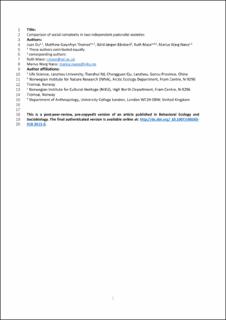| dc.contributor.author | Du, Juan | |
| dc.contributor.author | Thomas, Matthew | |
| dc.contributor.author | Bårdsen, Bård-Jørgen | |
| dc.contributor.author | Mace, Ruth | |
| dc.contributor.author | Næss, Marius Warg | |
| dc.date.accessioned | 2021-01-08T14:24:03Z | |
| dc.date.available | 2021-01-08T14:24:03Z | |
| dc.date.created | 2019-01-31T14:29:15Z | |
| dc.date.issued | 2019 | |
| dc.identifier.citation | Behavioral Ecology and Sociobiology. 2019, 73 (4), 1-10. | en_US |
| dc.identifier.issn | 0340-5443 | |
| dc.identifier.uri | https://hdl.handle.net/11250/2722242 | |
| dc.description.abstract | Pastoralists rely on networks of cooperating households containing relatives and others to help with production and various other daily activities. To understand how socioecological differences and commonalities affect different social networks, we compared cooperative decision-making using gift games for 755 people working in herding groups across six sites in two countries (Saami areas in Norway and Tibetan areas in China). We found that members of the same herding group received more gifts from each other.Most variance in gift-giving between study sites was due to differences in the effects of relatedness. Tibetan herdersweremore likely than Saami herders to give gifts to closer relatives belonging to geographically distant herding groups. Also, stated reasons of giving gifts were different in the two societies: kin and wealth (measured by herd size) were more important among Tibetan pastoralists, while reciprocity was more important among Saami. Social ties within and beyond the family as well as the centrality of herding groups within social networks are general patterns of social organization favoring cooperation among pastoralists. Evolution of cooperation . Social networks . Field experiment . Social institutions | |
| dc.language.iso | eng | en_US |
| dc.title | Comparison of social complexity in two independent pastoralist societies | en_US |
| dc.type | Peer reviewed | en_US |
| dc.type | Journal article | en_US |
| dc.description.version | acceptedVersion | |
| dc.source.pagenumber | 1-10 | en_US |
| dc.source.volume | 73 | en_US |
| dc.source.journal | Behavioral Ecology and Sociobiology | en_US |
| dc.source.issue | 4 | en_US |
| dc.identifier.doi | 10.1007/s00265-018-2611-6 | |
| dc.identifier.cristin | 1670647 | |
| dc.relation.project | Norges forskningsråd: 240280) | |
| dc.relation.project | Andre: Nordforsk | |
| dc.relation.project | Andre: NORDFORSK | |
| cristin.unitcode | 7530,0,0,0 | |
| cristin.unitname | Norsk institutt for kulturminneforskning | |
| cristin.ispublished | true | |
| cristin.fulltext | postprint | |
| cristin.fulltext | | |
| cristin.qualitycode | 1 | |
